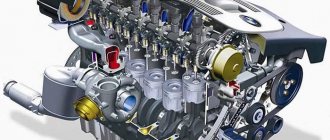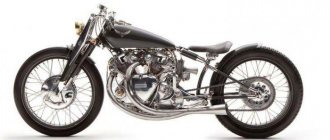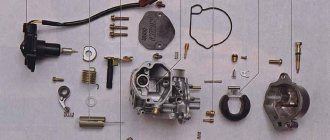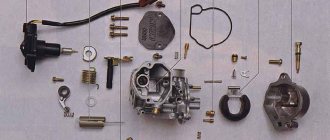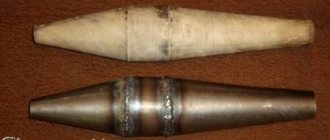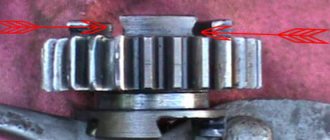Currently, two main types of internal combustion engines (ICEs) are actively used: two-stroke and four-stroke. In two-stroke engines, all operating cycles: intake of the finished fuel mixture, exhaust gas exhaust and purge, occur within one revolution crankshaft in two main steps. Engines of this type do not have timing valves; their role is played by a pair of piston and liner. As the piston moves, it closes the inlet, outlet and purge windows. Therefore, such engines are simpler in design and reliable, and under certain conditions, more powerful. Previously, there were two-stroke trucks, but they were crushed by environmental requirements.
Two-stroke diesels
Few people know that not so long ago there were two-stroke diesel engines with a dry sump, which were successfully operated in the USSR until the 90s. A distinctive feature of such a two-stroke engine was the presence of a gas distribution mechanism, which had only a pair (or one) exhaust valves, but the intake was carried out in the classical way for two strokes - through purge windows. Such engines include YaAZ-204 and YaAZ-206 [1], tank engines 5TDF (700 hp) and 6TDF-2 (1200 hp) [2]. Another attractive difference from its gasoline counterpart is that the diesel engine was purged with air, and not with a working mixture, as in the gasoline version, so the efficiency of the two-stroke diesel engine was comparable to the four-stroke version.
Engine drawings here
The power of a two-stroke engine with the same liter tank size and shaft speed is approximately 50-70% greater than a four-stroke engine due to the greater number of operating cycles per unit time. However, incomplete use of the piston stroke for expansion, poorer release of the cylinder from residual gases and the expenditure of part of the generated power on purging lead to an increase in power of only 60...70% compared to a four-stroke internal combustion engine.
Features of a two-stroke motor
A two-stroke engine completes a full cycle in one revolution of the crankshaft, this allows one to obtain greater specific liter power than a 4-stroke engine at the same engine speed. However, the efficiency of a two-stroke engine will be lower due to imperfections in the valve timing mechanism, inevitable losses of the fuel mixture during the purging process and incomplete piston stroke.
A two-stroke engine gets very hot because a lot of thermal energy is released during operation. Sometimes additional cooling may be required. Motorcycles rarely use two-stroke engines with a large number of cylinders; most often a single-cylinder air-cooled engine is used.
When operating on a two-stroke cycle, the piston makes fewer movements per stroke, and the load of auxiliary gas distribution, lubrication and cooling systems on the crankshaft is lower or absent altogether. Therefore, they will have less wear on the piston group. If this is not a decisive factor for light equipment, then a low-speed two-stroke diesel engine can have several times longer service life than all other internal combustion engines. Therefore, they are widely used in diesel locomotives, generators, and ship engines.
The two-stroke petrol engine reaches maximum power faster. This is actively used by motorcyclists, especially in cross-country disciplines, when an instant response to the throttle is required. In addition, it is easier to maintain, cheaper and lighter than a four-stroke.
The fuel consumption of a two-stroke engine will be 25-30% higher, as well as noise and vibration. The engine cannot comply with strict environmental standards, even if you use injection intake systems and supercharging. High air flow requires the use of special air filters.
General summary of the engine
A two-stroke engine consists of a crankcase (its main part is the base), in which the crankshaft is mounted on ball bearings. The cylinder is attached to the block through screws or studs that pass through the entire body of the liner. A piston moves inside the cylinder - a metal cup (usually made of an aluminum alloy), surrounded by spring rings (piston rings) inserted into grooves on the piston below the hot zone. During compression or the power stroke, the piston rings do not allow gases to pass through and are locked in the space between the piston bottom and the cylinder walls. The piston is equipped with a metal rod - a pin; it connects the piston to the connecting rod. The connecting rod transmits the linear reciprocating motion of the piston into the rotational motion of the crankshaft.
All rubbing surfaces and bearings inside two-stroke engines are lubricated using a fuel mixture into which the required amount of oil is mixed. From the animation it is clear that the fuel mixture (blue color) enters both the crank chamber of the engine (this is the cavity where the crankshaft is fixed and rotates) and into the cylinder. There is no lubricant there anywhere, and even if there was, it would have been washed away by the fuel mixture. This is the reason why oil is added in a certain proportion to gasoline. The type of oil used is special, specifically for two-stroke engines. It must withstand high temperatures and, when burned together with the fuel, leave a minimum of ash deposits.
Standards and characteristics
Current standards provide for the use of two brands of oils. These brands are designated as 2T or TS-W3.
2T oil for lubrication of two-stroke engines is used on mechanisms with air-cooled engines. This could be a chain saw or chainsaw, a lawnmower, a motorcycle or a scooter.
TC-W3 oil is used for engines designed for water cooling. For example, the Mercury boat drive. If the boat has an air-cooled drive, then you can use 2T motor oil to lubricate outboard motors.
In areas with low atmospheric temperatures, a special lubricant with low viscosity is used for drives of units such as a snowmobile.
The table summarizes the characteristics of 2T and TC-W3 motor oils.
| Name | Unit | Index | |
| Brand 2T | BrandTS-W3 | ||
| Kinematic viscosity, t=100°С | mm2/s | 13.5-15.5 | 6.8-7.1 |
| Minimum viscosity index | 90 | 85 | |
| Maximum ignition t in an open crucible | °C | 210 | 110 |
| Minimum pour t | °C | 16 | 19 |
| Minimum Base Number | mg KOH/1g oil | 2.0 | 1.8 |
| Density at t=20°С, no more | g/cm3 | 0.9 | 0.86 |
| Sulfate ash content, no more | % | 0.16 | 0.11 |
Four-stroke engines are more economical. They also provide good control of air intake and exhaust cycles, resulting in cleaner operation.
In a two-stroke cycle, some of the fuel is wasted as it escapes during the intake and compression strokes. Conversely, in a four-stroke cycle, no fuel is consumed during the intake of the air-fuel mixture because the fuel is drawn into a closed system.
The use of oil and gas mixtures in two-stroke engines also reduces combustion efficiency and increases harmful emissions (burnt oil).
Operating principle
Compression stroke.
The piston moves from bottom dead center (BDC) to top dead center (TDC), first closing the purge window and then the exhaust window. After the piston closes the exhaust window in the cylinder, compression of the combustible mixture that previously entered it begins. At the same time, in the crank chamber, due to its tightness, and after the piston closes the purge windows, a vacuum is created under the piston, under the influence of which a ready-made combustible mixture enters the crank chamber from the intake manifold through the inlet window and the slightly open valve.
Power stroke.
When the piston is positioned near TDC, the compressed working mixture is ignited by an electric spark from the spark plug, as a result of which the temperature and pressure of the gases increase sharply. Under the influence of thermal expansion of gases, the piston moves to BDC (while the expanding gases perform useful work). At the same time, going down, the piston creates excess pressure in the crank chamber. Under the influence of this pressure, the valve closes, thus preventing the combustible mixture from returning to the intake manifold and carburetor. When the piston reaches the exhaust window, it opens and the exhaust gases begin to be released into the atmosphere of our beloved Earth - the pressure in the cylinder decreases. With further movement, the piston opens the purge window and the combustible mixture compressed in the crank chamber flows through the channel, filling the cylinder and purging it of exhaust gas residues.
Thermal and dynamic calculation of internal combustion engines
Ignition principle. Since the fuel mixture takes time to ignite, the spark appears at the plug a little earlier than the piston reaches TDC. Ideally, the faster the piston moves, the earlier the ignition should be - the piston reaches TDC faster from the moment of spark. There are mechanical and electronic devices that change the ignition angle depending on engine speed. Almost for scooters before 2000. There were no such systems and the ignition timing was set statically for optimal speed.
Operating procedure
The stages described constitute the operating cycle of a four-stroke gasoline engine. You need to understand that there are no strict correspondences between strokes and processes in piston engines. This can easily be explained by the fact that during operation of the power unit, the phases of the gas distribution mechanism and the state of the valves will be superimposed on the movements of the pistons in different engines in completely different ways.
In any cylinder, the working cycle of a four-stroke carburetor engine proceeds in exactly this way. Each combustion chamber in the engine is needed to rotate a single crankshaft, which receives the force from the pistons.
This alternation is called the operating order. This order is set at the design stage of the power unit through the features of the camshaft and crankshaft. It does not change during operation of the mechanism.
The operating order is implemented by alternating sparks that arrive at the spark plugs from the ignition system. So, a four-cylinder engine can operate in the following orders - 1, 3, 4, 2 and 1, 2, 4, 3.
View gallery
You can find out the order in which the engine cylinders operate from the instructions for the car. Sometimes the operating procedure is indicated on the unit body.
This is how the working cycle of a four-stroke carburetor engine or any other engine proceeds. The power supply system does not affect the operating principle of the unit in any way. The only difference is that a carburetor is a mechanical power system that has certain disadvantages, but in the case of injectors, these disadvantages are not present in the system.
Repair of two-stroke internal combustion engines
Repair of two-stroke internal combustion engines is carried out only by qualified workers according to technological and route maps developed by engineers and designers. These instructions allow the worker to understand where and when to use this or that operation, how and in what order to install parts, as well as in what sequence and with force to tighten them.
The “two-stroke” machines themselves are installed in special tilting stands, which allow the correct assembly and pulling of its components to be carried out visually and conveniently.
The development of an internal combustion engine repair process includes not only a visual inspection and washing of the entire assembly in a washing machine, but also the development of parts defect maps, restoration route maps, etc.
This is exactly how repairs of two-stroke internal combustion engines are carried out in the production conditions of ATP.
Disadvantages of two-stroke engines:
1. Higher fuel consumption. Let us remind you that the approximate consumption can be calculated using the formula: for a two-stroke 300 grams per horsepower, for a four-stroke 200 grams. 2. Noisy. At maximum speed, two-stroke engines tend to be slightly louder than four-stroke engines. 3. Comfort. Four-stroke internal combustion engines do not vibrate as much at low speeds (applies only to two-cylinder engines - single-cylinder two-stroke and four-stroke engines vibrate approximately the same) and do not smoke as much as two-stroke engines. 4. Durability. Quite a controversial point. There is an opinion that two-stroke engines are less durable. On the one hand, this is understandable, because the oil for lubricating the rubbing elements of the engine is supplied along with gasoline, which means it does not work as efficiently as in four-stroke engines where the rubbing elements literally float in oil. But on the other hand, a four-stroke engine is much more complex in design than its competitor, consists of a much larger number of parts, and the golden principle of mechanics “The simpler the more reliable” has not yet been canceled. 5. High temperature and overheating of individual parts, due to more frequent flash of the working mixture in the cylinders. More intensive cooling is required. 6. Increased air consumption (double), which leads to rapid failure of the air purification system filters. The T-64 and T-80UD (T-84) tanks had this problem.
Preparing the mixture
The fuel mass ratio must be accurate and calculated according to the manufacturer's recommendations. It is not recommended to dilute by eye, because an insufficient amount of oil in the mixture and an excess of it will cause engine damage. To mix, you need to select the type of fuel, the brand of lubricant and how much oil you want to pour into the gasoline.
Gasoline selection
To prepare the fuel mixture, unleaded gasoline of grades not lower than AI-90 is used. Previously, AI-80 was used for this, which was cheaper than others, but over time this type of gasoline left the fuel market. The best option was AI-92. Do not use fuel that is not recommended by the manufacturer for a specific engine. This will quickly disable it.
When refueling and storing gasoline, a number of recommendations must be taken into account. You cannot pour gasoline into plastic containers because:
- This can cause a fire, because plastic is a material that can generate static electricity when rubbed.
- On contact, gasoline breaks down plastic. Its microparticles get into the fuel, which leads to the preparation of a poor-quality mixture for a two-stroke engine.
Choosing oil for two-stroke internal combustion engines
For a two-stroke engine, you must purchase branded oils of the API-TB or API-TC class. The instructions for equipment or gas-powered tools will necessarily indicate the recommended brand of oil, which is also divided by viscosity and characteristics:
- mineral - for warm weather;
- semi-synthetic – mineral oils with improved qualities for all-season weather;
- synthetic - used in more severe times at low temperatures.
When purchasing oil, you must be guided by how much mixture is needed for the equipment. If you plan to use a lawn mower, then 1-2 liters is enough for the season. If it is a scooter or boat motor, then the quantity will be required much more. Based on the instructions, you can make the correct fuel calculation in advance.
Proportions of gasoline and oil
There is no clear answer to the question of how much oil is needed per liter of gasoline. Each gasoline two-stroke engine has its own proportion, taking into account power and period of use. The operating instructions indicate the indicators, and the ratio during the break-in period and subsequent operation differs.
For example, for garden equipment - mowers (trimmers), chainsaws, the proportionality of constant operation is 1:50, break-in is 1:40. The proportion of oil and gasoline for a boat motor is also individual: 1:25 – break-in, 1:40 – short period of operation, 1:50 – long-term operation. For walk-behind tractors and cultivators, more oil is needed: 1:20 – break-in, 1:30 – constant operation. Motorcycles and scooters will require even more oil. Here the proportions during break-in will be 1:15, and in the future a fuel mixture of 1:20 will be required.
The position that the more oil, the better or the principle “it can’t get worse” is not relevant. An increased concentration will cause increased engine wear because a layer of soot will form. Proportion must be accurate. For convenience, a fuel mixing table for two-stroke engines is used. It contains indicators that allow you to determine the need for gasoline and oil to prepare a certain amount of fuel, taking into account the required proportion.
